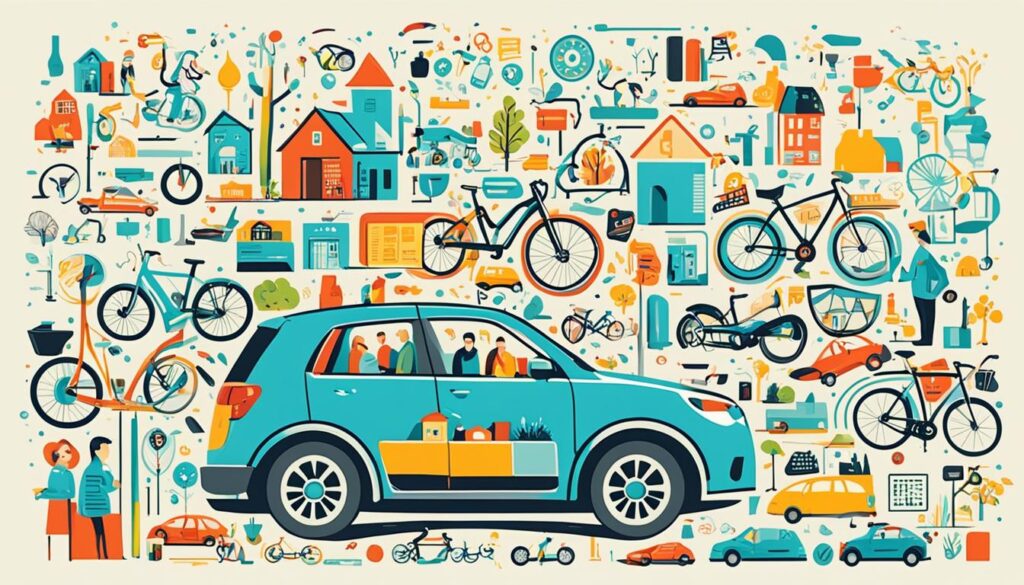Sharing is better than accumulating; we learn this from life. Now, technology allows us to live this philosophy in a new way. The sharing economy is changing how we consume and produce. Let’s see how it can benefit your wallet and the environment.
주요 시사점
- 그만큼 sharing economy includes initiatives such as exchanges, loans, equipment rentals, space sharing, and vehicle rentals.
- The 2008 crisis highlighted the sharing economy as a way to save resources.
- The sharing economy promotes conscious consumption, waste reduction, and democratizes access to products and services.
- Crowdfunding platforms and disruptive business models are examples of the sharing economy in action.
- The sharing economy transforms consumption habits by prioritizing quality, durability, sustainability, and social justice.
What is the Sharing Economy?
The sharing economy is a way to save and be more fair. It uses resource sharing to improve everyone’s lives. The fundamental principles are: conscious consumption, waste reduction, and effective use of what we have. This includes exchanges, loans, rentals, as well as carpooling and item rentals.
Benefits for Individuals and the Environment
For individuals, the sharing economy brings many benefits. It helps access more products and services for less money, and can also provide extra income. For the planet, it helps reduce waste and make better use of resources. This includes carpooling, property rentals, and shared workspaces.
| Benefits for Individuals | Benefits for the Environment |
|---|---|
| Greater access to products and services | Reduction of waste |
| Lower cost and more convenience | Better use of resources |
| Opportunities for extra income | Contribution to sustainability |
“The sharing economy creates new markets, produces job opportunities, and revitalizes concepts of ‘sharing’ and business models.”
How Did the Sharing Economy Emerge?
The sharing economy is not a new concept. Models like thrift stores and bazaars have existed for a long time. However, during the global economic crisis of 2008, it gained prominence.
This crisis led people to seek ways to save money and be more environmentally conscious. Technology and the importance of millennials were also significant factors.
Origins and Driving Factors
The mobility offered by transport apps and the growth of coworking spaces helped create new collaborative businesses. Crowdfunding platforms also emerged, enabling the financing of new ideas.
Pioneering Examples of Initiatives
Early examples include Uber, the ride-sharing platform, and Airbnb, for property rentals. Kickstarter is also an example of crowdfunding.
These initiatives have changed sectors such as transportation and accommodation. They have connected people and made access to goods and services more democratic. Other examples are coworking spaces and platforms for selling used products, like Enjoei 그리고 OLX.
“The global market for the sharing economy could reach $335 billion by 2025.”
The sharing economy emerged in the 21st century, driven by factors such as market instability and employment issues. It was also influenced by environmental concerns and the public’s debt after the 2008 financial crisis.
This model has brought positive changes to the economy. It has benefited various sectors, promoted conscious consumption, and helped generate income in new businesses.
Sharing Economy in Action
The sharing economy is creating disruptive business models. It changes how we use goods and services. Companies like Uber and iFood use shared cars and labor to offer transportation and delivery.
Platforms like Airbnb and Enjoi allow renting properties and buying used products. This makes it easier to access things without buying them. Thus, we save and make better use of resources.
Popular Platforms and Apps
There are many popular platforms and apps in the sharing economy. Uber and 99 are for transportation. iFood and Rappi are for food delivery. Airbnb is for property rentals.
Enjoi and OLX are for selling used products. Buser and BlaBlaCar help share trips. Coworking platforms and crowdfunding platforms are also in the market. These digital tools make resource sharing easier and more accessible.

In the gig economy, more than a third of workers in the US are independent. About 60 million people work this way. It is expected that 50% of the workforce will be freelance in ten years.
“The sharing economy is providing new entrepreneurial and job opportunities, driven by technologies, online platforms, and the rise of freelance work.”
Goals and Pillars of Collaborative Economy
The sharing economy aims to encourage conscious consumption and reduce waste. It seeks to make better use of available resources. Additionally, it aims to democratize access to products and services, benefiting everyone involved and improving society.
The pillars of the collaborative economy are:
- Sharing of goods and services: Initiatives like carpooling, property rentals, and coworking seek to improve resource use and increase access.
- 의식적인 소비: The collaborative economy reduces waste and promotes sharing, decreasing environmental impact and encouraging a sustainable lifestyle.
- Democratization of access: It aims to make products and services more accessible to more people.
- Generation of mutual benefits: The collaborative economy seeks to benefit all parties involved, whether providers, users, or society.
Challenges and Future Perspectives
The sharing economy faces several challenges:
- Legal and regulatory issues: The sharing economy often faces challenges in adapting to existing laws and regulations.
- Quality control and safety: Ensuring the quality and safety of shared products and services is crucial.
- Technological development: Technological innovation is necessary to meet the growing demand and adapt to market needs.
- Consumer trust: Building trust between users and providers is essential for the success of sharing platforms.
Despite these challenges, the future of the sharing economy is promising. It is expected to continue growing, driven by technological advancements, increasing consumer awareness, and the ongoing search for more sustainable and efficient solutions.
We hope this article has helped you understand the sharing economy better. Share this information with your friends and let’s spread this idea together!
